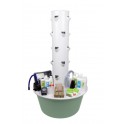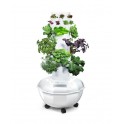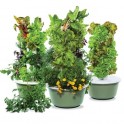Terahertz waves offer significant advantages in fields such as medical imaging, chemical substance detection, and the...
5 Advantages Of Growing Your Own Veggies
Growing your own vegetables can offer numerous advantages. Here are five benefits of growing your own veggies:
-
Healthier and Fresh Produce: When you grow your own vegetables, you have complete control over the cultivation process. You can choose to use organic methods, avoid harmful pesticides, and harvest them when they are at their peak freshness. This allows you to enjoy healthier and more flavorful produce packed with essential nutrients.
-
Cost Savings: Growing your own veggies can save you money in the long run. While there might be some initial investment in setting up a garden, the cost of seeds or seedlings is generally much lower than buying vegetables from the grocery store. Additionally, you can save on transportation costs since your garden is right at your doorstep.
-
Environmental Benefits: By growing your own vegetables, you contribute to a more sustainable and eco-friendly lifestyle. You reduce the need for long-distance transportation, which saves energy and reduces carbon emissions. Furthermore, you have control over the use of pesticides and fertilizers, allowing you to adopt more environmentally friendly practices.
-
Emotional Well-being: Gardening can be a therapeutic and stress-relieving activity. Spending time in nature, nurturing plants, and witnessing their growth can provide a sense of accomplishment, relaxation, and connection with the natural world. It can also serve as a great way to unwind and escape the pressures of daily life.
-
Educational and Family Bonding: Growing your own veggies provides a wonderful opportunity for learning and education, especially for children. It helps them understand where their food comes from, teaches them about plant life cycles, and instills a sense of responsibility. Gardening can also be a shared activity, bringing family members together and fostering teamwork and cooperation.
Overall, growing your own vegetables empowers you to make healthier choices, save money, reduce your environmental impact, and enjoy the satisfaction of nurturing plants while creating lasting memories.
Related products
-
-
TowerGarden Home
Price: CAD$870.00New TowerGarden Home, Your indoor garden. Shipping to Canada, USA -
Tower Garden Family Garden
Price: CAD$2,538.00Your family will surely grow healthier with the help of our Tower Garden...
Related posts
-
Advantages of Terahertz Waves
1821 views 2 Liked 0 commentsTerahertz waves offer significant advantages in fields such as medical imaging, chemical substance detection, and the...
-
Glutathione . The Tiny Molecule with a Big Impact
5977 views 6 Liked 0 commentsThe Tiny Molecule with a Big Impact: Glutathione and Its Importance in Human Health
-
The benefits of a living food cure
Posted in: HomeSeptember 5th 201711819 views 7 Liked 0 commentsA living food cure has powerful depurative effects, notably thanks to the use of foods with a high enzymatic...
-
What are the benefits of PEMF ?
8237 views 12 Liked 0 commentsPEMF, which stands for Pulsed Electromagnetic Field therapy, is a non-invasive and drug-free approach that uses...
-
 Setting Up Your Tower Garden Home
11788 views 30 Liked 0 commentsAssembling your Tower Garden HOME indoor garden is simple and easy. Each TowerGarden HOME box comes with...
Setting Up Your Tower Garden Home
11788 views 30 Liked 0 commentsAssembling your Tower Garden HOME indoor garden is simple and easy. Each TowerGarden HOME box comes with...





















Leave a comment
Log in to post comments